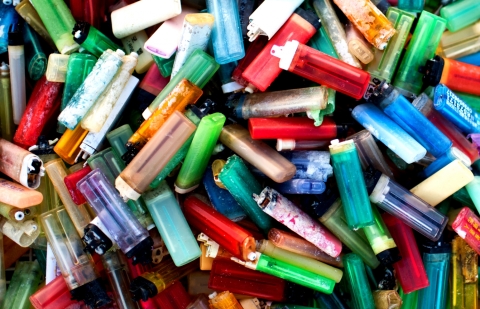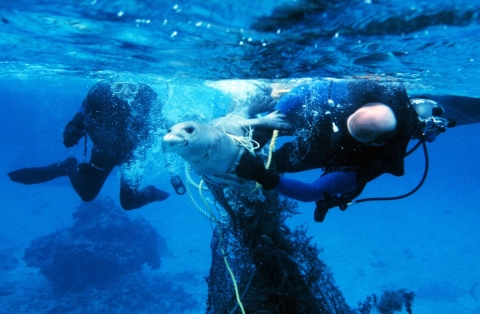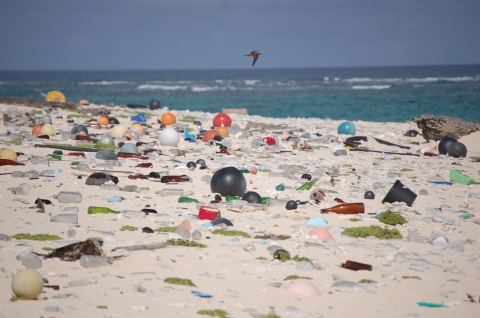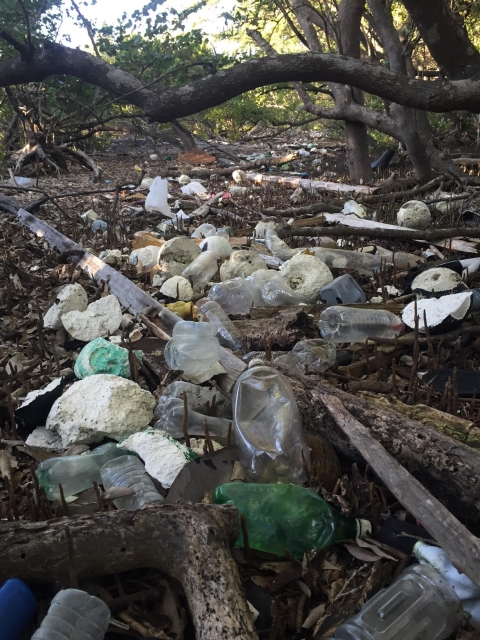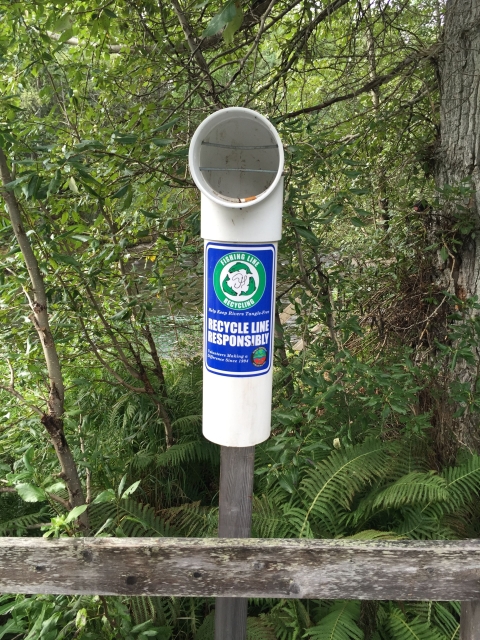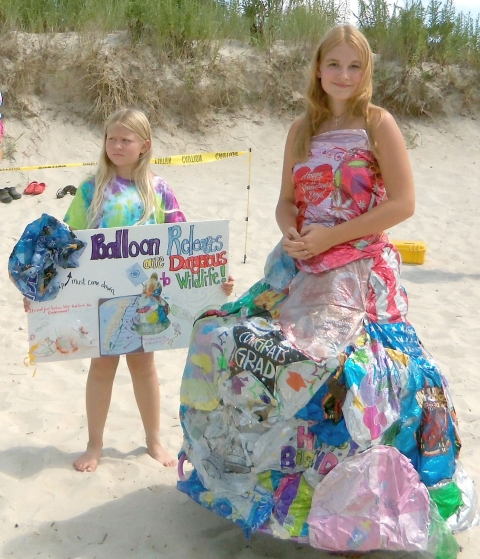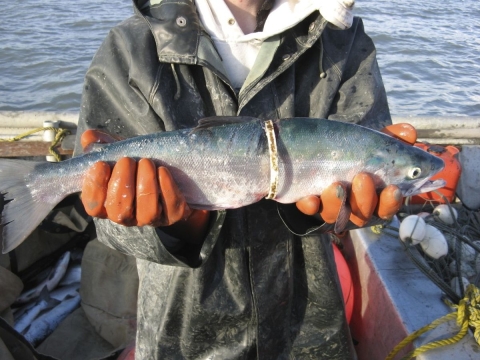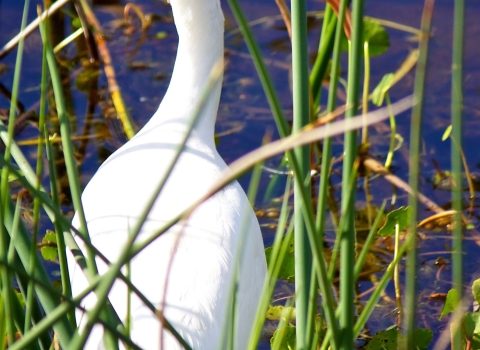Eww. That’s a nasty photo above. But what’s it got to do with you? More than you might think.
The photo comes from Midway Atoll National Wildlife Refuge in the Pacific, where seaborne debris endangers the world's largest albatross colony. When adult albatrosses skim the ocean surface for food, they pick up plastic scrap, too. Then they feed it to their hungry chicks on Midway. Some of these chicks die, their stomachs full of trash.
What you may not know: The trash doesn’t come from anywhere near Midway. It comes from China, from Indonesia, from the United States. It comes from us.
And we can do something about it. Some would argue we have to.
Bottle caps, cigarette lighters, bags and bottles, soda cans that we discard on land make up most of the swirling mass known as marine debris. Rivers and storm sewers carry it to the sea, where abandoned boats and fishing nets add to the menace.
More than 14 million tons of plastic enter the ocean each year, outpacing efforts to remove it.
What’s scarier still: The global problem affects more than wildlife. Plastics have entered the human food chain, through the water we drink and the fish we eat. The impact on human health is not yet fully known.
But here’s the thing. If we recognize we’re part of the problem, we can take steps to curb it at the source.
Action: Buy fresh and local. Avoid excess packaging. Use reusable cloth bags instead of plastic bags. Dispose of waste responsibly. Reduce. Reuse. Recycle.
“Marine debris is one of the most pervasive and pernicious global threats to the health of the world’s coastal areas, oceans and waterways,” former U.S. Fish and Wildlife Service deputy director Jim Kurth testified to a Senate subcommittee in May 2016. The 180 national wildlife refuges that protect ocean, coast or Great Lakes habitat know the problem firsthand.
Nearly every seabird on the planet now eats plastic. Fish are eating microplastics — tiny beads found in cosmetics, lotions and toothpaste. Toxic chemicals bind to microplastics, and fish swallow these, too. When we eat the fish, we also swallow the microplastics and the toxins.
“Everybody’s seen pictures of beaches strewn with plastic,” says Pete Leary, marine coordinator for the National Wildlife Refuge System. “But people in Portland or Washington, DC, generally don’t think of marine debris when they’re forgetting to put their trash in bins in a park.”
They should.
Tiny Midway Atoll Refuge, located within the Papahānaumokuākea Marine National Monument, has become a poster child for marine debris awareness. Why is that?
One reason is the atoll’s remoteness — more than 1,300 miles from the nearest city. “If you go to coastal California and see junk on beach, you think it probably came from Los Angeles or San Diego,” says Leary, who lived and worked on Midway for five years between 2007 and 2014. “But basically none of the stuff washing up is locally generated.”
Another reason: Midway’s location. It sits close to the gyre, a Pacific Ocean current that pulls ocean debris into the swirling mass known as the Great Pacific Garbage Patch. “All Hawaiian islands are impacted,” says Leary. An estimated 23 tons of debris accumulates on Midway Atoll each year.
And there is the atoll’s abundant wildlife. Nearly three million seabirds nest on Midway, including endangered Laysan ducks and the world’s largest colony of albatross. So it’s hard to miss plastic’s devastating impact on birds and animals.
Elsewhere in the Papahānaumokuākea Marine National Monument, at Kure Atoll — the most remote of the Northwestern Hawaiian Islands — the U.S. Fish and Wildlife Service and the Hawaii Department of Land and Natural Resources have removed debris from more than 280 acres of coral reefs and beaches. This effort helped restore seabird nesting habitat for the endangered Laysan duck and reduce entanglement risks for sea turtles and the endangered Hawaiian monk seal.
Action: Spread the word about the need to curb marine debris. For a heartbreaking look at the toll on Midway’s seabirds, see this trailer for the upcoming feature film “Albatross" by photographer Chris Jordan. Or see CNN’s video “Plastic Island.”
For a lighter touch, check out Ocean Today’s short “Trash Talk” videos, a collaboration between the National Oceanic and Atmospheric Administration and the Smithsonian Institution.
Derelict commercial fishing nets are a particular menace. Snagged on offshore rocks and reefs, they entrap birds, seals and endangered sea turtles. Between 2006 and 2015, NOAA removed an average 37.7 metric tons a year of discarded nets from the Northwest Hawaiian Islands. A story map follows a NOAA team’s removal of 22,000 pounds of debris over three days in 2018.
Hauling the heavy nets out of the surf and off the beach is hard work. “We’re lucky we have lots of people helping to clean up,” says Joseph Schwagerl, project leader for six Hawaiian refuges, including James Campbell National Wildlife Refuge in Oahu, where he’s based.
Disposal is the next challenge. Remote islands must ship debris by barge to the mainland, where it often ends up as landfill — an imperfect fix that the next big storm could undo. Some people are exploring alternatives. One novel Hawaii program burns debris to create usable energy. Since 2002, the effort has generated enough electricity from more than 800 tons of derelict nets to power nearly 350 Hawaii homes for a year.
Action: Take part in the next International Coastal Cleanup — the largest volunteer effort for our oceans. Dozens of refuges and refuge Friends groups participate. Or plan a small cleanup yourself. Find out how from the Ocean Conservancy.
In the Florida Keys refuges, marine debris poses other cleanup challenges.
“When trash gets in the mangroves, which make up a lot of our shoreline, it’s virtually impossible to clean out,” says Kristie Killam, ranger for four national wildlife refuges in the Florida Keys; the refuges lie within the Florida Keys National Marine Sanctuary. That’s because much of the dense tangle of partly submerged roots is nearly inaccessible by land or boat.
“A lot of [the trash] is plastic,” says Killam. “A lot of it is Styrofoam. All of it’s going to be here for a long time. Key deer, birds and other wildlife wander the shorelines. On a daily basis they get entangled in the trash and accidentally ingest it too.”
Attempts to flee Cuba — 90 miles away — produce another kind of litter at Key West National Wildlife Refuge, a breeding ground for colonial nesting birds and sea turtles and a designated wilderness.
Abandoned Cuban “chugs” — homemade boats carrying hazardous fuels and oils — litter the Marquesas Keys, says Killam. “We have dozens there now and they can be an impediment to nesting sea turtles and young turtles leaving the nest. They also take away from the wilderness character of the refuge.”
Action: Follow your state or county guidelines for safe disposal of fuel, paint and other hazardous waste. In Maryland, for example, the Department of Natural Resources offers these tips (pdf) on safe disposal.
Off Florida’s west coast at J.N. “Ding” Darling National Wildlife Refuge, debris cleanup efforts focus on discarded fishing gear.
A “Mind Your Line” campaign started by the refuge and several partners offers anglers tips on how to dispose of fishing line and tackle safely to prevent wildlife injury and entanglement.
Every Friday volunteer members of the monofilament crew paddle refuge waters in kayaks to remove fishing line from the estuary. The past president of the “Ding” Darling Wildlife Society, the refuge’s Friends group, heads the crew. In 2017-18 retrieval was low after a toxic algae bloom and Red Tide spoiled fishing. In 2016-17, crew members collected 507 hooks, 249 lead sinkers, 114 bobbers and enough fishing line to fill a five-gallon bucket — the equivalent of 1.22 miles of line.
To reduce plastic waste, the refuge has stopped sales of bottled water (installing water refilling stations instead) and the use of plastic bags in the society’s nature store and gift shop. The store also sells non-plastic straws and cold water in a recyclable plant-based container.
Action: Carry reusable water bottles for a day at the beach, the ballpark and other places. While you’re at it, keep a reusable coffee mug at hand, too, instead of adding to the 25 billion Styrofoam cups we throw away each year.
Kenai National Wildlife Refuge in Alaska enlists anglers in keeping refuge waters clean. Volunteers with Stream Watch, a partnership of Chugach National Forest and the Kenai Watershed Forum (a local nonprofit), make it easy for them. Anglers deposit their old fishing line in special containers installed throughout the Kenai River watershed. Volunteers install and empty the containers.
Action: Join with others to provide fishing line containers for anglers in your area. Persuade your community to ban disposable plastic bags and other single-use plastics.
People have found other novel ways to call attention to marine debris and the threat it poses to wildlife.
Some years back at Eastern Shore of Virginia National Wildlife Refuge, a teenage volunteer stationed herself on the beach, done up in a “dress” she made from the shreds of 87 balloons collected from a coastal island. She did it after hearing how turtles sometimes mistake the Mylar scraps for food and choke on them, and seabirds get strangled by balloon strings.
Her message: Don’t release balloons into the air – not if you treasure wildlife.
Marine debris fouls shores in Alaska, too — even in the most remote areas. “It was the single most surprising thing to me when I came to the refuge,” says Steve Delehanty, manager of Alaska Maritime National Wildlife Refuge, which stretches along the state’s extensive coast and far into the Bering Sea. “The beaches are full of fishing lines, nets, buoys, plastic water bottles, and all kinds of weird stuff. Plastic water bottles are everywhere. You step in the tall beach rye grass on a remote Aleutian island, hear a plastic crunch, and it’s a water bottle hidden in the grass nine times out of ten.”
Refuge crews and volunteers collect some debris for disposal in Homer and Adak landfills. But they barely make a dent in it.
“The beach cleanup work itself can be disruptive to sensitive wildlife,” says Delehanty, “and the next tide just brings in more trash. You don’t want to go back to the beach and push, pull, disentangle, and disturb everything month after month, year after year. It is important to stop allowing trash into the ocean, not just picking it up when it lands on a beach.”
Action: Choose products with eco-friendly packaging, such as edible six-pack rings and biodegradable paper boxes, instead of hard plastic.
What else can you do to reduce marine debris?
- See suggestions from the Friends of Midway Atoll National Wildlife Refuge. While you’re on the site, check out the short video “Are You Eating Plastic for Dinner?”
- Use NOAA’s marine debris tracker app to alert monitors to trash that you find on coasts and waterways. See NOAA’s suggestions on ways you can help reduce marine debris as anglers, beachgoers and boaters.
- Consider actions recommended by California’s nonprofit Thank You Ocean Campaign.
- Stay current. As a member of the Interagency Marine Debris Coordinating Committee, the U.S. Fish and Wildlife Service works with other federal agencies to conduct marine debris research, monitoring and cleanup. Read the committee’s latest report to Congress (pdf) on the status of marine debris and cleanup efforts.
- Visit Marine Debris, Ocean Litter, and How it Affects Wildlife in the Northeast
- Keep plugging … and don’t lose hope.
“Sometimes it can get you down seeing new debris come in every day, but you have to keep working to remove it,” says Joseph Schwagerl, project leader for the Hawaii refuges. “You have to do what you can to protect and conserve habitat for wildlife.”


